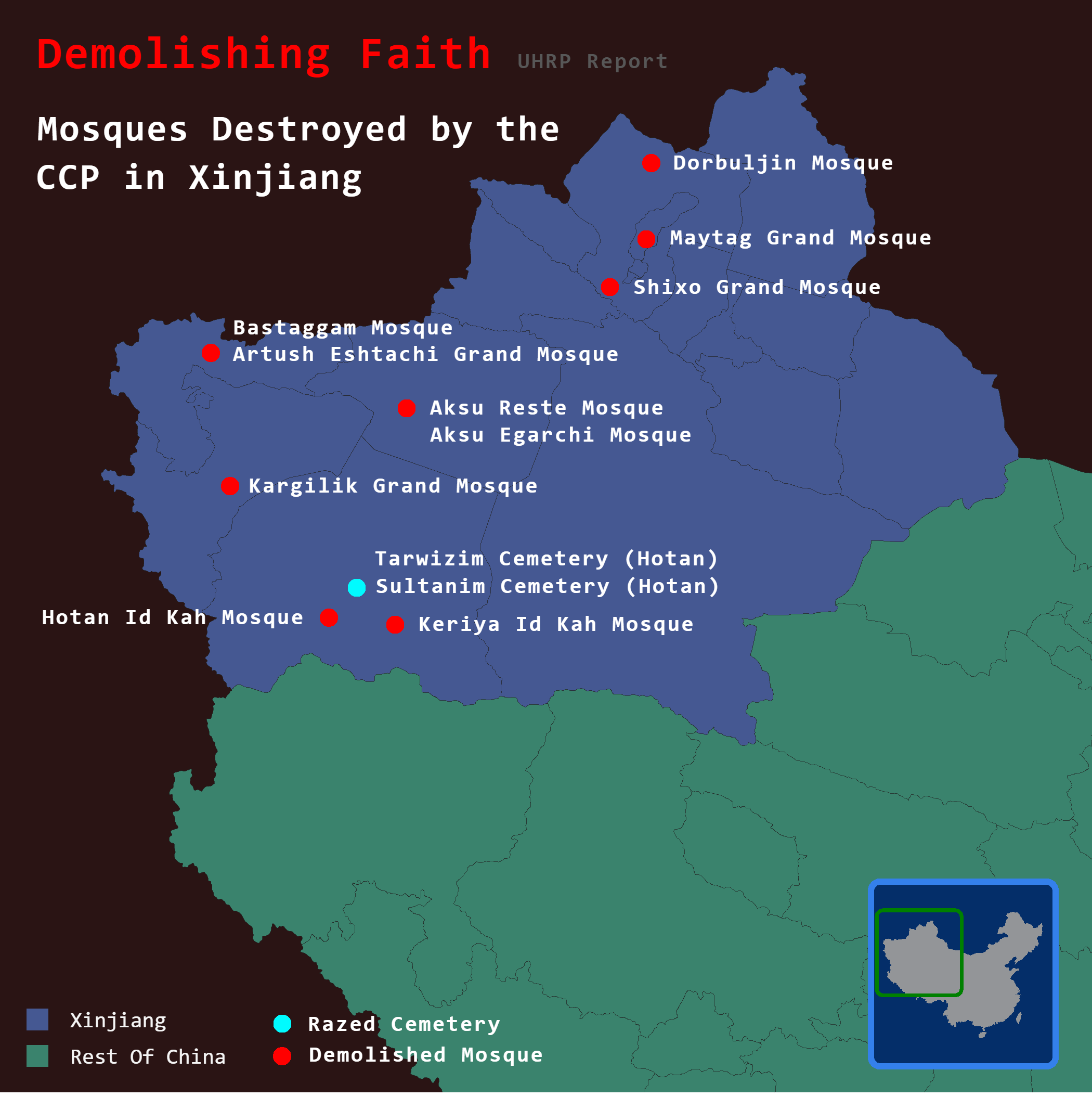Destroyed Mosques and Islamic Cemeteries Map in Xinjiang


Alex Cartwright
Senior Cartographer & GIS Specialist
Alex Cartwright is a renowned cartographer and geographic information systems specialist with over 15 years of experience in spatial analysis and data...
Geographic Analysis
What This Map Shows
The visualization titled "Destroyed Mosques & Islamic Cemeteries In Xinjiang, China" provides a stark representation of the religious and cultural destruction faced by the Uyghur Muslim community in Xinjiang. It highlights the locations of demolished mosques and desecrated Islamic cemeteries, drawing from the detailed findings of the Uyghur Human Rights Project (UHRP) report, "Demolishing Faith: The Destruction and Desecration of Uyghur Mosques and Shrines." This map serves not only as a geographical representation but also as a poignant reminder of the ongoing human rights violations in the region.
Transitioning from the visualization, it’s crucial to delve into the historical and cultural significance of these places of worship and burial grounds for the Uyghur people. Mosques and cemeteries are more than mere structures; they are centers of community life, spiritual guidance, and cultural identity. The destruction of these sites signals a broader attempt to erase Uyghur cultural and religious practices.
Deep Dive into Religious and Cultural Significance
The mosques and cemeteries depicted on this map are integral to the identity of the Uyghur people. Xinjiang, located in the far northwest of China, is home to a predominantly Muslim population, with rich traditions intertwined with Islam. Historically, mosques in the region have served as places of worship, community gathering, and education. They are architectural manifestations of Uyghur culture, often adorned with intricate designs that reflect the region's historical influences from Persian, Turkish, and Central Asian styles.
Interestingly, the UHRP report reveals that over 16,000 mosques have been destroyed or altered since 2017, which is a staggering number considering the region once boasted one of the highest densities of mosques in the world. This obliteration of religious sites is part of a broader campaign by the Chinese government to suppress Uyghur identity under the guise of counter-terrorism and national security. Have you noticed that such practices often accompany authoritarian regimes? The destruction of religious sites not only aims to dismantle community cohesion but also to instill fear among the population.
Moreover, the cemeteries hold immense significance for the Uyghur community. They are places where families come together to remember their ancestors, honor their legacies, and practice cultural rituals. The desecration of Islamic cemeteries, as reported, includes razing tombstones, removing the remains of the deceased, and converting burial sites into public parks or military installations. This is not merely an act of vandalism; it is a calculated effort to sever the ties that bind the Uyghur people to their history and heritage.
Regional Analysis
Looking at the map with a regional lens reveals significant disparities in the destruction of mosques and cemeteries across different areas of Xinjiang. For instance, in urban centers like Urumqi and Kashgar, the rate of demolition appears to be higher compared to more rural areas. This could be attributed to the Chinese government's focus on urbanization and control in larger cities, making them more prone to surveillance and intervention.
In contrast, rural communities, while still facing the threat of destruction, may not experience the same intensity of oversight. However, the fear of reprisals means that many rural Uyghurs are also reluctant to speak out about the loss of their cultural sites. What’s fascinating is that even in the face of destruction, some communities have found ways to preserve their heritage through oral traditions and clandestine practices. This resilience speaks volumes about the strength of cultural identity amidst adversity.
Significance and Impact
The destruction of mosques and cemeteries in Xinjiang is a pressing issue that transcends geography; it touches on fundamental human rights, cultural preservation, and the fight against oppression. Why does this matter, you may ask? The implications of such actions are profound—not only for the Uyghur community but for global human rights advocacy. As cultural sites vanish, so too do the stories and histories they embody, leading to a homogenization of culture that favors state-sponsored narratives.
Furthermore, the international response has been mixed. While some countries and organizations condemn these actions, others remain silent, often for geopolitical reasons. This silence can embolden further violations. As we look to the future, it’s crucial to raise awareness about these issues and to advocate for the protection of cultural heritage in Xinjiang and beyond. The map serves as a call to action, urging us to recognize and address the human costs of cultural erasure.
As we continue to monitor the situation, it’s essential to remember that each dot on this map represents not just a location but a story—a story of faith, resilience, and an ongoing struggle for identity in the face of adversity.
Visualization Details
- Published
- September 27, 2025
- Views
- 52
Comments
Loading comments...